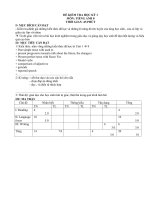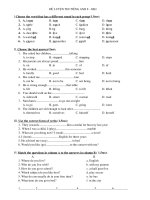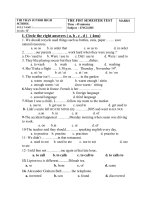Đề thi tiếng anh đề TEST 8
Bạn đang xem bản rút gọn của tài liệu. Xem và tải ngay bản đầy đủ của tài liệu tại đây (64.86 KB, 6 trang )
Mark the letter a, b, c, or d on your answer sheet to indicate the underlined sound that is pronounced
differently from the rest or the word that differs from the rest in the position of the main stress:
Question 1. A. expansion
B. conversion
C. precision
D. explosion
Question 2. A. eradicate
B. character
C. malaria
D. spectacular
Question 3 A. appetite
B. architect
C. appreciate
D. arable
Question 4 A. deliberate
B. subsequent
C. frequently
D. consequent
Question 5 A. insight
B. chemist
C. dependent
D. substance
Mark the letter A, B, C, or D on your answer sheet to show the underlined part that needs correction in
each of the following questions.
Question 6: If you need to keep (A) fit, then why not take(B) on (C) a sport (D) such as badminton or
tennis?
Question 7: When her dog died(A), she cried (B) very hardly (C) for half an hour (D) .
Question 8: The purpose of the United Nations, broadly speaking (A), is to maintain peace and security (B)
andencourage (C) respect for human rights (D).
Question 9: Although caffeine is a moderately (A) habit-forming (B) drug, coffee is not regarded
as harmfully (C) to the average healthy (D) adult.
Question 10: Televisions are now an everyday (A) feature of most households (B) in the United States,
and television viewing (C) is the number-one activity leisure (D).
. Mark the letter A, B, C, or D on your answer sheet to indicate the correct answer to each of the
following questions.
Question 11: ______ English fluently, we should practice speaking it whenever possible.
A. In order to speak
B. In order speak
C. their accepting
D. they accept
Question 12: As a general rule, the standard of living ______ by the average output of each person in
society.
A. fixed
B. has fixed
C. is fixed
D. fixes
Question 13: She's finished the course, ______?
A. isn't she
B. hasn't she
C. doesn't she
D. didn't she
Question 14: Although the weather is not so good, the match will ______.
A. go about
B. go ahead
C. go over
D. go along
Question 15: The greater the demand, ______ the price.
A. the highest
B. the high
C. higher
D. the higher
Question 16: I was under_______that you two had already met.
A. the impression
B. the idea
`
C. notice
D. pressure
Question 17: Are you sure you can do it on_________?
A. yourself
B. secret
C. date
D. your own
Question 18: I don’t think we can_______him to change his mind.
A. insist
B. make
C. persuade
D. suggest
Question 19: Can you help me sort_______these clothes into different sizes?
A. between
B. out
C. with
D. for
Question 20: I just can’t________that noise any longer!
A. sit out
B. stand in for
C. stand up for
D. put up with
Question 21: Last year ABBA made a ________of several million crowns.
A. win
B. gain
C. salary
D. profit
Question 22: If you like skiing, there’s a ski ____________under an hour’s driving from Madrid.
1
A. resort
B. station
C. place
D. port
Question 23: If you are ‘over the moon’ about something, how do you feel?
A. stressed
B. very
C. very happy
D. bored
Question 24: He’s very ________about his private life. He’s got no secrets.
A. trustworthy
B. direct
C. open
D. sincere
Question 25: You must________these instructions very carefully.
A. carry out
B. bring out
C. carry on
D. get up to
Question 26: If she________rich, she would travel around the world.
A. would be
B. is
C. has been
D. were
Question 27: Mary was the last applicant________.
A. to be interviewed
B. to be interviewing
C. to interview
D. to have interviewed
Question 28: Argentina________Mexico by one goal to nil in the match.
A. beat
B. scored
C. won
D. knocked
Question 29: There should be no discrimintion on______________ of sex, race or religion.
A. fields
B. places
C. areas
D. grounds
Mark the letter A, B, C or D on your answer sheet to indicate the word that is closest meaning to the
underlined part in each of the following questions.
Question 30. That he should ask her to marry him was ratherpresumptuous on his part.
(A) audacious
(B) stupid
(C) brave
(D) nice
Question 31. Voluntarism is a tradition in the United States, but how people realize that up to fifty-two
percent of the adult population is engaged in some kind of volunteer service?.
(A) need
(B) business
(C) diversion
(D) custom
Question 32. Because of extreme pressure underwater, divers are oftensluggish.
(A) slow
(B) hurt
(C) careful
(D) worried
Question 33. Some sedimentary rocks are made entirely of very large coral beds.
(A) unusual
(B) mature
(C) massive
(D) subterranean
Question 34. Many countries nowadays restrict the exportation of genuinearcheological artifacts.
(A) particular
(B) rare
(C) authentic
(D) costly
Read the following passage and mark the letter A, B, C, or D on your answer sheet to indicate the correct
word for each of the blanks from 51 to 60 .
Mobile phones ____(51)____ microwave radio emissions. Researchers are questioning whether
exposure to these radio waves might ____(52)____ to brain cancer.
So far, the data are not conclusive. The scientific evidence does not ____(53)____ us to say with
certainly that mobile phones are categorically ____(54)____. On the other hand, current research has not yet
____(55)____clear adverse effects associated with the prolonged use of mobile phones.
Numerous studies are now going ____(56)____in various countries. Some of the results are
contradictory but others have shown an association between moblie phone use and cancer. ____(57)____,
these studies are preliminary and the issue needs further, long-term investigation.
2
____(58)____the scientific data are more definite, it is prudent for people to try not to use mobile
phones for long ____(59)____of time. Don’t think that hands-free phones are any safer either. At the
moment, research is in fact showing the ____(60)____ and they may be just as dangerous.
It is also thought that young people whose bodies are still growing may be at particular risk.
Question 35:
Question 36:
Question 37:
Question 38:
Question 39:
Question 40:
Question 41:
Question 42:
Question 43:
Question 44:
A. emit
A. cause
A. enable
A. safe
A. proved
A. by
A. Though
A. Provide
A. amounts
A. fact
B. sent
B. bring
B. make
B. risky
B. demonstrated
B. on
B. Additionally
B. As
B. quantities
B. opposite
C. give
C. produce
C. able
C. unhealthy
C. caused
C. through
C. However
C. When
C. periods
C. way
D. charge
D. lead
D. let
D. secure
D. produced
D. about
D. While
D. Until
D. intervals
D. truth
Read the following passage and mark the letter A, B, C, or D on your answer sheet to indicate the correct
answer for each of the questions from 61 to 70.
Scientists do not yet thoroughly understand just how the body of an individual becomes sensitive to a
substance that is harmless or even wholesome for the average person. Milk, wheat, and egg, for example,
rank among the most healthful and widely used foods. Yet these foods can cause persons sensitive to them to
suffer greatly. At first, the body of the individual is not harmed by coming into contact with the substance.
After a varying interval of time, usually longer than a few weeks, the body becomes sensitive to it, and an
allergy has begun to develop. Sometimes it's hard to figure out if you have a food allergy, since it can show
up so many different ways. Your symptoms could be caused by many other problems. You may have rashes,
hives, joint pains mimicking arthritis, headaches, irritability, or depression. The most common food allergies
are to milk, eggs, seafood, wheat, nuts, seeds, chocolate, oranges, and tomatoes. Many of these allergies will
not develop if these foods are not fed to an infant until her or his intestines mature at around seven months.
Breast milk also tends to be protective. Migraines can be set off by foods containing tyramine,
phenathylamine, monosodium glutamate, or sodium nitrate. Common foods which contain these are
chocolate, aged cheeses, sour cream, red wine, pickled herring, chicken livers, avocados, ripe bananas,
cured meats, many Oriental and prepared foods (read the labels!). Some people have been successful in
treating their migraines with supplements of B-vitamins, particularly B6 and niacin. Children who
are hyperactive may benefit from eliminating food additives, especially colorings, and foods high in
salicylates from their diets. A few of these are almonds, green peppers, peaches, tea, grapes. This is the diet
made popular by Benjamin Feingold, who has written the book “Why your Child is Hyperactive”. Other
researchers have had mixed results when testing whether the diet is effective.
Question 45: The topic of this passage is ____________.
A. reactions to foods
B. food and nutrition
C. infants and allergies
D. a good diet
3
Question 46: According to the passage, the difficulty in diagnosing allergies to foods is due
to____________.
A. the vast number of different foods we eat
B. lack of a proper treatment plan
C. the similarity of symptoms of the allergy to other problems
D. the use of prepared formula to feed babies
Question 47: The word "symptoms" in line 7 is closest in meaning to ____________ .
A. indications
B. diet
C. diagnosis
D. prescriptions
Question 48: The phrase "set off" in lines 11 is closest in meaning to_____ .
A. relieved
B. identified
C. avoided
D. triggered
Question 49: What can be inferred about babies from this passage?
A. They can eat almost anything.
B. They should have a carefully restricted diet as infants.
C. They gain little benefit from being breast fed.
D. They may become hyperactive if fed solid food too early.
Question 50: The word "hyperactive" in line 15 is closest in meaning to _____.
A. overly active
B. unusually low activity
C. excited
D. inquisitive
Question 51: The author states that the reason that infants need to avoid certain foods related to allergies
has to do with the infant's ____________.
A. lack of teeth
B. poor metabolism
C. underdeveloped intestinal tract
D. inability to swallow solid foods
Question 52: The word "these" in line 16 refers to_____.
A. food additives
B. food colorings
C. unnutritious foods
D. foods high in sacilates
Question 53: Which of the following was a suggested treatment for migraines in the passage?
A. Eating more ripe bananas
B. Avoiding all Oriental foods
C. Getting plenty of sodium nitrate
D. Using Vitamin B in addition to a good diet
Question 54: According to the article the Feingold diet is NOT _____.
A. verified by researchers as being consistently effective
B. available in book form
C. beneficial for hyperactive children
D. designed to eliminate foods containing certain food additives
Read the following passage and mark the letter A, B, C, or D on your answer sheet to indicate the correct
answer to each of the questions from 71 to 80.
No educational medium better serves as a means of spatial communication than the atlas. Atlases deal
with such invaluable information as population distribution and density. One of the best, Pennycooke's
World Atlas, has been widely accepted as a standard owing to the quality of its maps and photographs,
which not only show various settlements but also portray them in a variety of scales. In fact, the very first
map in the atlas is a cleverly designed population cartogram that projects the size of each country if
geographical size were proportional to population. Following the proportional layout, a sequence of smaller
maps shows the world's population density, each country's birth and death rates, population increase or
decrease, industrialization, urbanization, gross national product in terms of per capita income, the quality of
medical care, literacy, and language. To give readers a perspective on how their own country fits in with the
global view, additional projections depict the world's patterns in nutrition, calorie and protein consumption,
health care, number of physicians per unit of population, and life expectancy by region. Population density
4
maps on a subcontinental scale, as well as political maps, convey the diverse demographic phenomena of the
world in a broad array of scales.
Question 55: What is the main topic of this passage?
A. The educational benefits of atlases
C. The ideal in the making of atlases
B. Physical maps in an atlas
D. Partial maps and their uses
Question 56: According to the passage, the first map in Pennycooke's World Atlas shows _______.
A. the population policy in each country
C. geographical proportions of each country
B. the hypothetical sizes of each country
D. national boundaries relative to population
Question 57: Which of the following sentences is TRUE about the atlas?
A. A country's population growth is presented clearly in the very first map in the atlas.
B. The atlas isn't as good as other educational medium in term of spatial communication.
C. The atlas provides readers with not only each country's life expectancy by religion but also its language
and literacy.
D. The atlas deals with such worthless information as population distribution and density.
Question 58: The word "cleverly" in the passage is closest in meaning to _______.
A. clearly
B. immaculately
C. intelligently
D. accurately
Question 59: Which of the following is NOT mentioned in the passage?
A. Calorie consumption
C. A level of educations
B. Currency exchange rates
D. Population decline
Question 60: The word "layout" in the passage refers to _______.
A. the cartogram
B. the geographical size
C. population
D. each country
Question 61: The phrase "in terms of" used in the passage is closest in meaning to _______.
A. for considering aspects
B. in spite of
C. with a view to
D. in regard to
Question 62: It can be inferred from the passage that maps can be used to_______.
A. pinpoint ethnic strife in each country
C. give readers a new perspective in their own country
B. identify a shortage of qualified labour
D. show readers photographs in a new form
Question 63: The author of the passage implies that__________.
A. atlases provide a bird's eye view of countries
projection
C. maps of countries differ in size
B. maps use a variety of scales in each
D. atlases can be versatile instrument
Question 64: The word "convey" in the passage is closest meaning to__________.
5
A. devise
B. conjure up
C. demonstrate
D. indicate
PART II. WRITING A.
1. The doctor said, “You really ought to rest for a few days, Jasmine.”
The doctor strongly
……………………………………………………………………………………………..
2. “I will pay back the money, Gloria.” Said Ivan.
Ivan promised …………………………………………………………………………………………..
3. The children couldn’t do swimming because the sea was too rough.
The sea was too …………………………………………………………………………………………..
4. “Would you like to come to my birthday party, Sarha?” asked Frederic.
Frederic invited …………………………………………………………………………………………..
5. “If I were you, I would take the job,” said my room-mate.
My room-mate …………………………………………………………………………………………...
B. In about 140 words, write a paragraph about your dream job.
6





![Tài liệu [Luyện thi tiếng Anh] REVISION TEST 1 ppt](https://media.store123doc.com/images/document/13/ce/pe/medium_pex1386933310.jpg)



